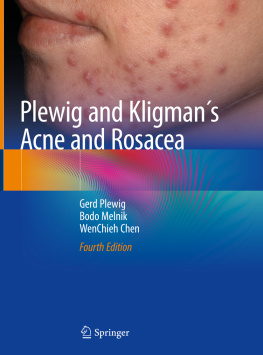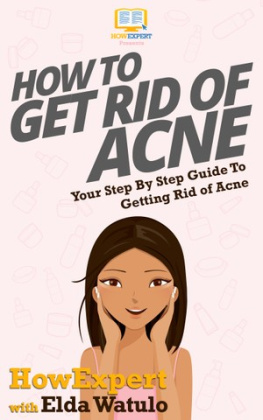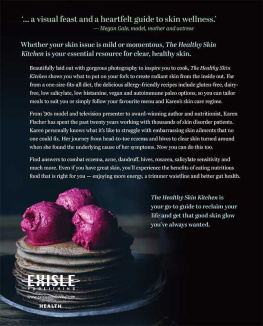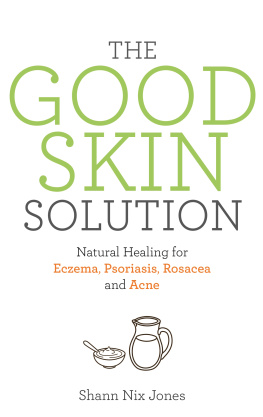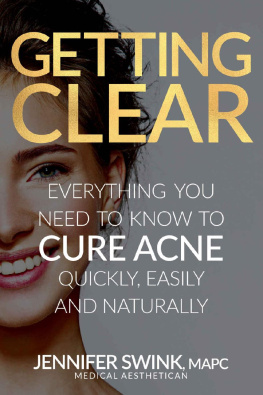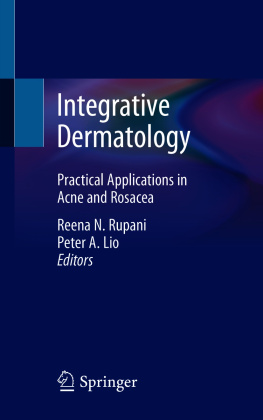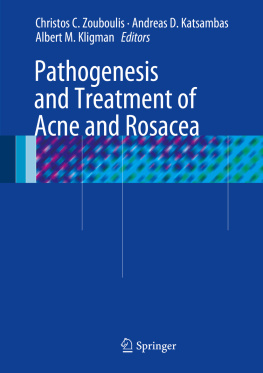Gerd Plewig - Plewig and Kligman’s Acne and Rosacea
Here you can read online Gerd Plewig - Plewig and Kligman’s Acne and Rosacea full text of the book (entire story) in english for free. Download pdf and epub, get meaning, cover and reviews about this ebook. year: 2019, publisher: Springer International Publishing, genre: Romance novel. Description of the work, (preface) as well as reviews are available. Best literature library LitArk.com created for fans of good reading and offers a wide selection of genres:
Romance novel
Science fiction
Adventure
Detective
Science
History
Home and family
Prose
Art
Politics
Computer
Non-fiction
Religion
Business
Children
Humor
Choose a favorite category and find really read worthwhile books. Enjoy immersion in the world of imagination, feel the emotions of the characters or learn something new for yourself, make an fascinating discovery.
- Book:Plewig and Kligman’s Acne and Rosacea
- Author:
- Publisher:Springer International Publishing
- Genre:
- Year:2019
- Rating:4 / 5
- Favourites:Add to favourites
- Your mark:
- 80
- 1
- 2
- 3
- 4
- 5
Plewig and Kligman’s Acne and Rosacea: summary, description and annotation
We offer to read an annotation, description, summary or preface (depends on what the author of the book "Plewig and Kligman’s Acne and Rosacea" wrote himself). If you haven't found the necessary information about the book — write in the comments, we will try to find it.
Plewig and Kligman’s Acne and Rosacea — read online for free the complete book (whole text) full work
Below is the text of the book, divided by pages. System saving the place of the last page read, allows you to conveniently read the book "Plewig and Kligman’s Acne and Rosacea" online for free, without having to search again every time where you left off. Put a bookmark, and you can go to the page where you finished reading at any time.
Font size:
Interval:
Bookmark:
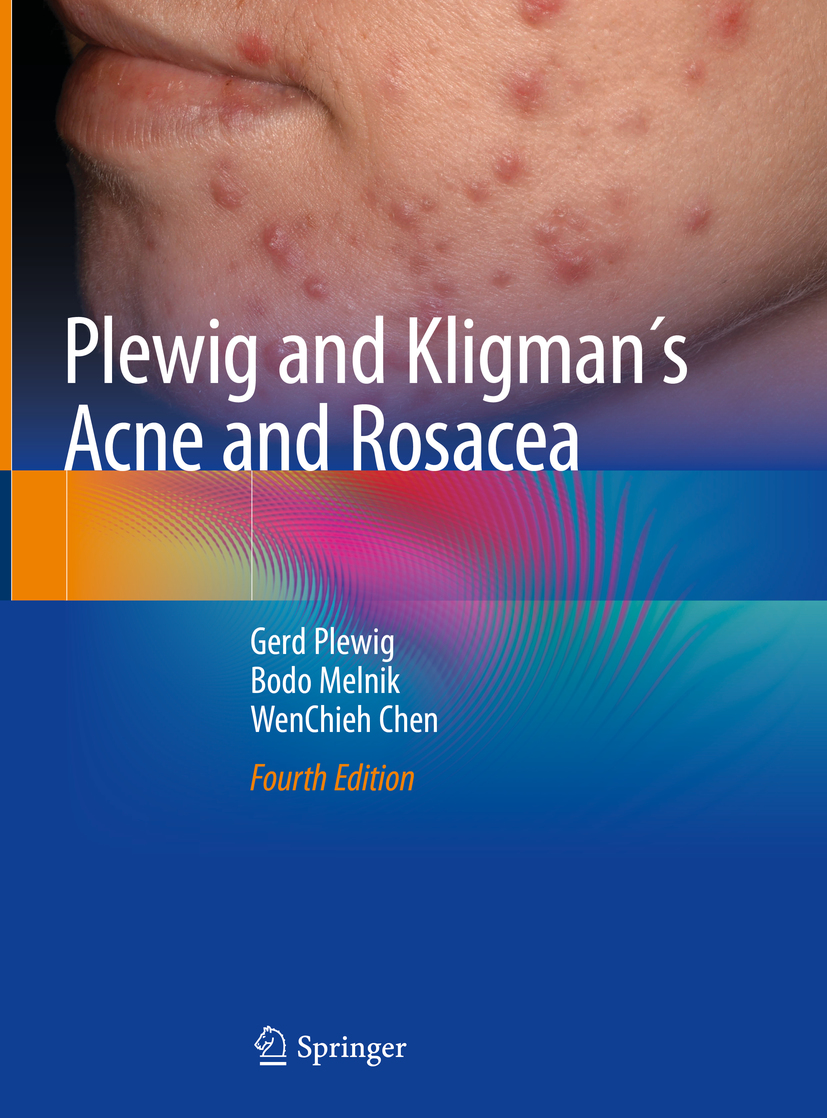

This Springer imprint is published by the registered company Springer Nature Switzerland AG
The registered company address is: Gewerbestrasse 11, 6330 Cham, Switzerland

In Memory of Albert Montgomery Kligman, M.D., Ph.D., Dr. hc. mult.
Philadelphia 17 March 1916Philadelphia 9 February 2010
MentorTeacherScientistPhysicianFriend
(Portrait. Oil on canvas, painted in 1995 by John Boyd Martin, who is born in 1936
Located outside the laboratory named for Albert M. Kligman,
Biochemical Research Building, Department of Dermatology,
University of Pennsylvania, Philadelphia
With kind permission, George Cotsarelis, M.D., Ph.D., Professor and Chairman)
To our wives, Helga, Susanne, and Pei-Hsiu
More than 50 years have elapsed since the first publication of this book, compiled and written with the brilliant ideas and energy of Albert Montgomery Kligman (19162010) from Philadelphia, one of the greatest experimental and clinical dermatologists of his time. Sadly enough, we miss him as an author of this new work but express our deepest gratitude to a lifelong teacher, mentor, and friend.
After the English editions (1975, 1993, 2000) and German editions (1978, 1994), time was ready for a new team of authors to continue this monograph. Colleagues the world over encouraged us to bring the vast new information on these common diseases, acne and rosacea, and also demodicosis and acne-associated autoinflammatory diseases into a new volume of text and atlas.
The growth of basic knowledge coupled with clinical experience since has been enormous. This has been a joyous enterprise for us. The ability to treat acne and rosacea effectively was accompanied by the vastly expanded understanding of their etiologies and pathogenesis, thanks to the remarkable input of eminent researchers and clinicians worldwide.
Acne is not only an eminently treatable disease; even worst cases, for example, acne conglobata and acne fulminans, are actually curable. No case is so severe as to be beyond help with the array of diverse drugs now available. Treatment failure is mostly physician failure. Prevention of acne in highly susceptible children is well possible with topical agents prescribed at the incipient stage, thus preventing the dreaded sequel of scarring.
We continue in the beliefs expressed in 1975 regarding our mission. This text and atlas is dedicated to dermatologists and other colleagues who must diagnose and treat these disfiguring, remarkably protean, common diseases.
This is a reference work for investigators, including a selective review of the literature. The references we cite have been selected for their relevance to daily practice, for their educational worth, and for their readability and historical impact. This meant for a massive culling of thousands of articles piled up in past decades. We apologize to those authors whose contributions are not listed here.
A quote from the first edition epitomizes our current attitude: We have sought to create a portfolio of still-life pictures of gross and microscopic anatomy of acne and rosacea. This will be a photographic record of what these maladies look like, their usual and unusual features
The views we present in respect to pathogenesis and treatment are in the first place our own and much less constructed from recommendations of other authorities. Thus, some of our proposals may not meet the stringent requirements of evidence-based medicine. Since this is a practice-orientated text, we have taken on the hazardous responsibility of expressing our personal options and not the many alternatives which can be found in the literature. Consensus conferences and guidelines, based on national or international participation, are helpful but may not be applicable to regional or in loco demands. We do not wish to pretend that no quandaries remain or that everything is simple and straightforward as our style might suggest.
Over the past years, new concepts of pathogenesis, new variants, new syndromes of acne, and new therapies have emerged. To name but a few, these include autoinflammatory syndromes of acne associated with arthritis and pyoderma gangrenosum, hidradenitis suppurativa/acne inversa now redefined as dissecting terminal hair folliculitis, the role of Demodex folliculorum mites in healthy people and diseased state, and the role of microbiota and biofilm. There is evidence to support our hypotheses concerning signal transduction pathways such as the role of FoxO1 and mTORC1 in acne, endoplasmic reticulum stress responses in rosacea, and the T cells and Th17 cells in dissecting terminal hair folliculitis, the impact of hyperglycemic food and milk, and the p53-associated sebocyte apoptosis caused by isotretinoin. Newly introduced drugs and topical remedies were discussed. Many acne-mimicking diseases are commonplace but can be confusing. Acne, syndromic constellations of acne, and rosacea not infrequently coexist in overlap mixtures, which may be present at the same time, with one slowly disappearing and the other emerging. Physicians must keep abreast with this fascinating new wealth of science.
Our patients expect that we physicians have enough time for them, listening is as important as looking. Even today, our well-educated patients and their custodians sometimes hold a bag full of irrational folkloristic beliefs and myths, which need to be dispelled. It is well accepted that placebo effects are prominent in medicine and, of course, in acne and rosacea alike. This explains why some popular, unproven remedies seem to work. Even in properly controlled studies, it is astonishing how often the efficacy of the vehicle approaches that of the active drug. Important regular changes took place in the last decades. Acne conglobata and severe inflammatory acne seem to be on the wane, possibly as the result of so effective treatments such as isotretinoin, oral antibiotics, and new topical formulations. Rosacea seems to steadily increase. We speculate that also epidemiological changes reflect the environmental exposure and nutrition. Furthermore, migration across continents and countries with new in loco circumstances of health care and living standards may have their impact on expression of these dermatoses.
Font size:
Interval:
Bookmark:
Similar books «Plewig and Kligman’s Acne and Rosacea»
Look at similar books to Plewig and Kligman’s Acne and Rosacea. We have selected literature similar in name and meaning in the hope of providing readers with more options to find new, interesting, not yet read works.
Discussion, reviews of the book Plewig and Kligman’s Acne and Rosacea and just readers' own opinions. Leave your comments, write what you think about the work, its meaning or the main characters. Specify what exactly you liked and what you didn't like, and why you think so.

